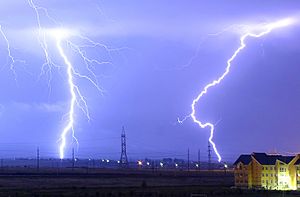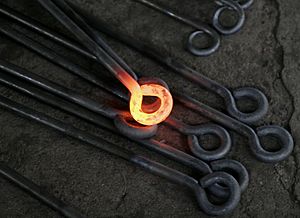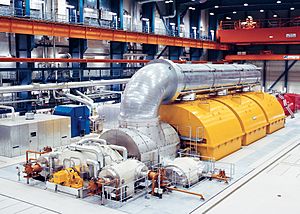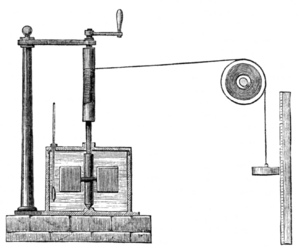Energy facts for kids

Energy is a very important idea in science, but it also has other meanings.
- In science, energy describes how much a physical system can change or do things. In physics, energy is a property of matter. It can move from one object to another and change its form. But it can never be made or destroyed.
- In economics, "energy" can mean the business of getting and selling power to people, like electricity or fuel.
- In everyday talk, if someone has a lot of "energy," it means they are lively and active!
Contents
What is Energy in Science?
In science, energy is what allows something to do work. Think of it as the ability to cause change or motion.
There are two main kinds of energy:
- Kinetic energy: This is the energy of things that are moving. A rolling ball has kinetic energy.
- Potential energy: This is stored energy. A ball held high up has potential energy because it can fall.
Energy Never Disappears
Energy cannot be made or destroyed. It only changes from one form to another. For example, when you rub your hands together, the kinetic energy of your moving hands changes into thermal energy, making your hands warm.
This important rule is called the "conservation law of energy." It means the total amount of energy in a closed system always stays the same.
Matter and Energy are Connected
Scientists now know that matter (the stuff everything is made of) can turn into energy, and energy can turn into matter. This happens in processes like nuclear fission (splitting atoms) and nuclear fusion (joining atoms).
Albert Einstein showed this with his famous formula: E = mc2. This means that energy (E) is equal to mass (m) multiplied by the speed of light (c) squared. It tells us that a tiny bit of mass can create a huge amount of energy!
Stone Throw Example
Let's look at how energy changes when you throw a stone:
- When you throw the stone, your muscles use chemical energy stored in them.
- As the stone flies upwards, it has kinetic energy because it's moving.
- At its highest point, just before it starts to fall, the stone has the most potential energy (stored energy due to its height).
- As the stone falls back down, its potential energy changes back into kinetic energy.
- When the stone hits the ground, its kinetic energy changes into thermal energy (making the ground slightly warmer) and sound energy (the thud you hear).
Different Kinds of Energy


Energy can be divided into many types. For example, classical mechanics talks about kinetic energy (from movement) and potential energy (from position).
Here are some common types of energy:
- Light energy: The energy from light, like from the sun or a lamp.
- Sound energy: The energy from vibrations that make sound.
- Renewable energy: Energy from sources that won't run out, like solar or wind.
- Solar energy: Energy that comes from the sun.
- Wind energy: Energy from the movement of wind.
- Nuclear energy: Energy released from the center of atoms.
- Elastic energy: Stored energy in stretched or squashed objects, like a spring.
- Gravitational potential energy: Stored energy due to an object's height in a gravitational field.
- Kinetic energy: Energy of motion.
- Dark energy: A mysterious form of energy thought to be causing the universe to expand faster.
- Internal energy: The total energy stored inside a system.
Heat and work are special because they are not types of energy that an object "has." Instead, they describe how energy is transferred from one place to another. We can't measure how much heat or work is in an object, only how much energy moves during a process.
How We Measure Energy
We can measure energy and give it a number. To make these numbers meaningful, we use special units.
Science Units for Energy
The main unit for energy and work in the SI is the joule (J). It's named after James Prescott Joule.
- One joule is equal to 1 newton-metre.
- In basic SI units, 1 J is the same as 1 kg m2 s−2.
For electricity, a common unit is the kilowatt-hour (kW·h).
- One kilowatt-hour is equal to 3,600,000 joules (or 3.6 million joules). This is how your home electricity bill is often measured!
Related pages
Images for kids
-
Thomas Young was the first person to use the word "energy" in the way scientists do today.
See also
 In Spanish: Energía para niños
In Spanish: Energía para niños




